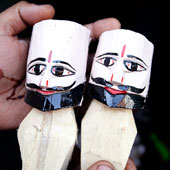The process of making puppet is very intricate and involves a lot of patience. The process is conducted by both men and women. In Jaipur the puppets made are of small size; with wooden heads, decorated with cloths and stuffed with chaan or cotton.
The making process can be categories into following steps:
- Making of the face
- Finishing
- Coloring
- Stitching
- Decoration
- Attaching of strings
- Performance
Making of the Face:
The puppet making process starts with the making of the face. Different characters have different facial structure and expression and are carved accordingly. This process is mainly done by the men and is called Chilaai. Craftsman, with the help of chisel and hammer painstakingly carve the face. The whole process takes around 3-4 hrs. Generally there is no difference in the face of the male and that of the female puppets. The puppets have no wooden hands and legs and these are made in cloth.
Finishing:
Once the face is made it is kept for drying, thereafter it is rubbed with the help of sandpaper and a then a coat of Plaster of Paris mixed with turpentine oil is applied on the surface of the face to fill the small holes on wood. Once it is dried it is again rubbed with sandpaper to remove the extra material and then touch wood is applied as the basic paint with the help of koochi and the face is kept for drying.
Coloring:
The dried face is finally coated with a pale white color matching to the skin color. The eyes are painted white, lips in red color and puppets depicting females are painted with red bindi on the forehead.
Stitching:
The decoration starts with preparing the cloths. These are hand stitched and stuffed with old cloths and rags. This is done mainly by the women. Puppets made for performances are decorated with great zeal. Women stitch cloths according to the nature of the characters. The one made for selling are decorated with cut pieces from sarees. Male and females are dressed with dhoti and lenhga respectively made out of similar sarees.
Decoration:
Heavy embellishment is done on the puppets which are meant for performance. They are decorated with handmade jewelry, instruments etc. to make them appear lively. These puppets are mainly sold as souvenirs and for this reason the female puppets have traditional gorla on their foreheads while the males have beens (Snake Charmers Flute) which depict the culture of Rajasthan.
Attaching of the Strings:
Since these are the string puppets; therefore attaching strings become the most important element of the puppets. Artisans use these strings to manipulate the puppets during performances. Proper location of the string is necessary for better maneuvering of the puppet’s actions. Strings are mainly attached with neck, shoulders, hands, legs and head of the puppet. These strings are either looped with the fingers of the puppeteer or to a small wooden strip which is operated by the lead puppeteer. The string attached to the head also connects to the back. These strings are strong cotton threads which can bear the load of the puppets. Finally the highly decorative and beautiful puppets are ready to perform on different traditional and contemporary themes.



















